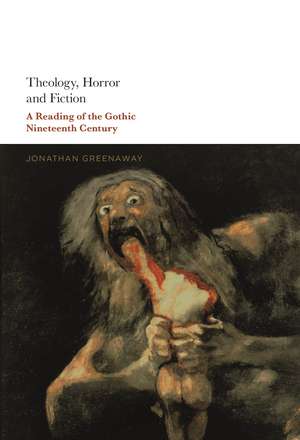Theology, Horror and Fiction: A Reading of the Gothic Nineteenth Century
Autor Dr Jonathan Greenawayen Limba Engleză Paperback – 27 iul 2022
| Toate formatele și edițiile | Preț | Express |
|---|---|---|
| Paperback (1) | 196.31 lei 6-8 săpt. | |
| Bloomsbury Publishing – 27 iul 2022 | 196.31 lei 6-8 săpt. | |
| Hardback (1) | 537.77 lei 6-8 săpt. | |
| Bloomsbury Publishing – 13 ian 2021 | 537.77 lei 6-8 săpt. |
Preț: 196.31 lei
Preț vechi: 257.25 lei
-24% Nou
Puncte Express: 294
Preț estimativ în valută:
37.58€ • 39.06$ • 31.16£
37.58€ • 39.06$ • 31.16£
Carte tipărită la comandă
Livrare economică 05-19 februarie 25
Preluare comenzi: 021 569.72.76
Specificații
ISBN-13: 9781501371356
ISBN-10: 1501371355
Pagini: 200
Dimensiuni: 152 x 229 mm
Greutate: 0.28 kg
Editura: Bloomsbury Publishing
Colecția Bloomsbury Academic
Locul publicării:New York, United States
ISBN-10: 1501371355
Pagini: 200
Dimensiuni: 152 x 229 mm
Greutate: 0.28 kg
Editura: Bloomsbury Publishing
Colecția Bloomsbury Academic
Locul publicării:New York, United States
Caracteristici
The author is thoroughly embedded in the rapidly growing field examining the intersections of the Gothic and theology and has a significant following on Twitter as a literary critic
Notă biografică
Jonathan Greenaway is Researcher in Theology and Horror at the University of Chester, UK.
Cuprins
AcknowledgementsIntroduction: Gothic [and religion] and theology1. Monstrosity and the problem of evil: A theologico-literary understanding of personhood in Frankenstein and Paradise Lost2. 'Sinners in the hands of an angry God': Gothic revelation and monstrous theology in the Gothic's Calvinist legacy3. Gothic writing and political theology: Wuthering Heights and Jane Eyre as theological texts4. 'Through a glass darkly': Reading the Victorian ghost story theologically 5. The limitations of materialism: Fin-de-siècle Gothic, sin and subjectivity and the insufficiency of degenerationConclusion: Through the Gothic castle, back to theologyBibliographyIndex
Recenzii
Jonathan Greenaway's Theology, Horror and Fiction: A Reading of the Gothic Nineteenth Century offers a critically important and intellectually nuanced perspective into the often neglected relationship between Gothic literature and theology, within a Christian framework.
Brilliantly redressing the hitherto overlooked relationship between Gothic literature and theology, Greenaway's book offers a sensitive and fresh way into 19th-century imaginings of monstrosity, evil, spectrality and sin. More than a spotlight on cultural, political and psychological anxiety, Greenaway's Gothic is an access point to the inexplicable existence of the supernatural in works by Shelley, Hogg, the Brontës and Wilde. Theology, Horror and Fiction ultimately reveals God in dark and terrifying places wherein the ordinary is made strange by the religious and mystical as much as by the weird and mysterious.
In Theology, Horror and Fiction, Greenaway demonstrates how 19th-century Gothic literature intervened in ongoing theological debates. But even more than this, he compellingly argues that the Gothic constituted - and continues to constitute - an imaginative theology in its own right, offering readers new ways of finding God at work in the world. In its careful examination of some of the most beloved novels of the 19th century, including Frankenstein, Wuthering Heights, Jane Eyre, and The Picture of Dorian Gray, this deeply researched and eminently accessible study will interest literary critics, as well as historians and religious studies scholars of all levels.
Theology, Horror and Fiction takes its place among recent scholarship that has recognized Gothic fiction's investment in theological debate and controversy. Through a series of nuanced close readings, Jonathan Greenaway shows 19th-century Gothic writers engaging creatively and often subversively with theological ideas, from images of divine and artistic creation to Calvinist hermeneutics and critiques of predestination. Greenaway reads 19th-century Gothic fiction not only as a genre that reflects the religious debates of its time, but as a creative resource for continued reflection on theological claims in the present.
Brilliantly redressing the hitherto overlooked relationship between Gothic literature and theology, Greenaway's book offers a sensitive and fresh way into 19th-century imaginings of monstrosity, evil, spectrality and sin. More than a spotlight on cultural, political and psychological anxiety, Greenaway's Gothic is an access point to the inexplicable existence of the supernatural in works by Shelley, Hogg, the Brontës and Wilde. Theology, Horror and Fiction ultimately reveals God in dark and terrifying places wherein the ordinary is made strange by the religious and mystical as much as by the weird and mysterious.
In Theology, Horror and Fiction, Greenaway demonstrates how 19th-century Gothic literature intervened in ongoing theological debates. But even more than this, he compellingly argues that the Gothic constituted - and continues to constitute - an imaginative theology in its own right, offering readers new ways of finding God at work in the world. In its careful examination of some of the most beloved novels of the 19th century, including Frankenstein, Wuthering Heights, Jane Eyre, and The Picture of Dorian Gray, this deeply researched and eminently accessible study will interest literary critics, as well as historians and religious studies scholars of all levels.
Theology, Horror and Fiction takes its place among recent scholarship that has recognized Gothic fiction's investment in theological debate and controversy. Through a series of nuanced close readings, Jonathan Greenaway shows 19th-century Gothic writers engaging creatively and often subversively with theological ideas, from images of divine and artistic creation to Calvinist hermeneutics and critiques of predestination. Greenaway reads 19th-century Gothic fiction not only as a genre that reflects the religious debates of its time, but as a creative resource for continued reflection on theological claims in the present.
